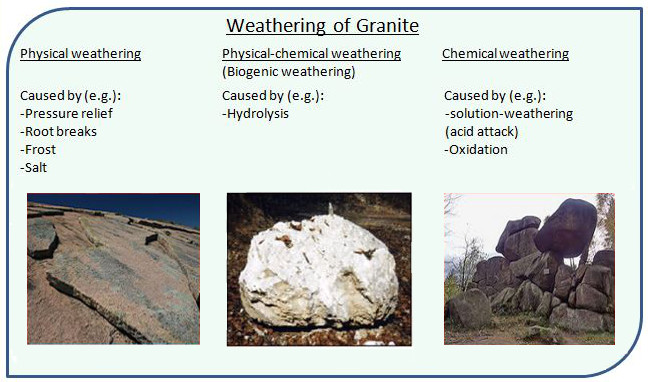Onion shells and wool sacks on the Seychelles EarthCache
Onion shells and wool sacks on the Seychelles
-
Difficulty:
-

-
Terrain:
-

Size:  (other)
(other)
Please note Use of geocaching.com services is subject to the terms and conditions
in our disclaimer.


The Seychelles are an archipelago which usually consists of continental rock, mostly granite. The Inner Islands comprise 43 islands, of which 41 are made of granite rock. These include, for example, Mahé, Praslin and La Digue. These names are well known to every visitor of the Seychelles, because some of the most beautiful beaches in the world are located there. Only Bird Iceland and Denis Iceland are two flat coral islands.
They are particularly known for the 750-million-year-old granite, in extreme formations due to the weathering process over millions of years, plus the turquoise warm water with its inhabitants contribute to its particular charm.
The weathering of granite results in several distinguishable types: Chemical, biogenic and physical. Often these results can be seen side by side at the same time. However, depending on their intensity and other environmental influences, they lead to very different results.
Physical weathering for example also includes pressure relief that forms cracks and crevices. In addition it can lead to separation of entire shells or to peeling and chipping of small fragments (desquamation). It is called onion-shell weathering. This can be seen on existing sharp edges in a layered weathering pattern, the so-called onion-shell weathering.
If the chemical weathering attacks the granite, for instance the minerals of the crystal lattice are replaced by H + ions during hydrolysis (acid attack). The intensity of the weathering increases with the temperature and the acid content of the water. As a result of this type of weathering are typically weathering images created, which remind of stacked woolen sacks and can easily be seen on vertically and horizontally running, strongly rounded edges while the granite body is still unscathed in the interior.
Biogenic weathering combines both physical and chemical processes. The rock is first blown up by plant roots, and the CO2 concentration is greatly increased by the respiration of soil organisms, which aids hydrolysis.

Your tasks:
Go to the given coordinates or as close as possible. You're standing there in front of a really high rock formation.
1. Please describe, in your own words, the look of the rock and its surface.
2. Estimate its height.
3. Does it appear onion-shell or woolen sacks weathering? Explain, why you think that!
4. Please research independently: In which other countries and/or regions are there especially good examples of the weathering you see here?
5. Now the mandatory question which proves your presence there.
Halfway from the parking lot to GZ will you see a ruin at stage 2. What can you see there exactly 7 times? You should not enter the Lost Place. The answer can be seen without problems from the beach side.
6. Optional: If you would take a nice photo of you, from the beach or of somewhere else on the seychelles and upload it to the log we would be very happy. Please no photos of the rock or of stage 2 which are showing the answers. We'll delete these photos.
Please note:
According to the guidelines you have not to wait for our permission, but send the answer e-mail immediately together with the log! No logs like: "Will send the answers later, when back home, when having better internet", etc. Such logs will deleted by us without prior notification. If your answers should be valid for another teams too, please provide their names.
 This photo doesn't show the rock at GZ, it's just nice/Dieses Foto zeigt nicht den Felsen an GZ, es ist nur schön.
This photo doesn't show the rock at GZ, it's just nice/Dieses Foto zeigt nicht den Felsen an GZ, es ist nur schön.
Additional Hints
(No hints available.)